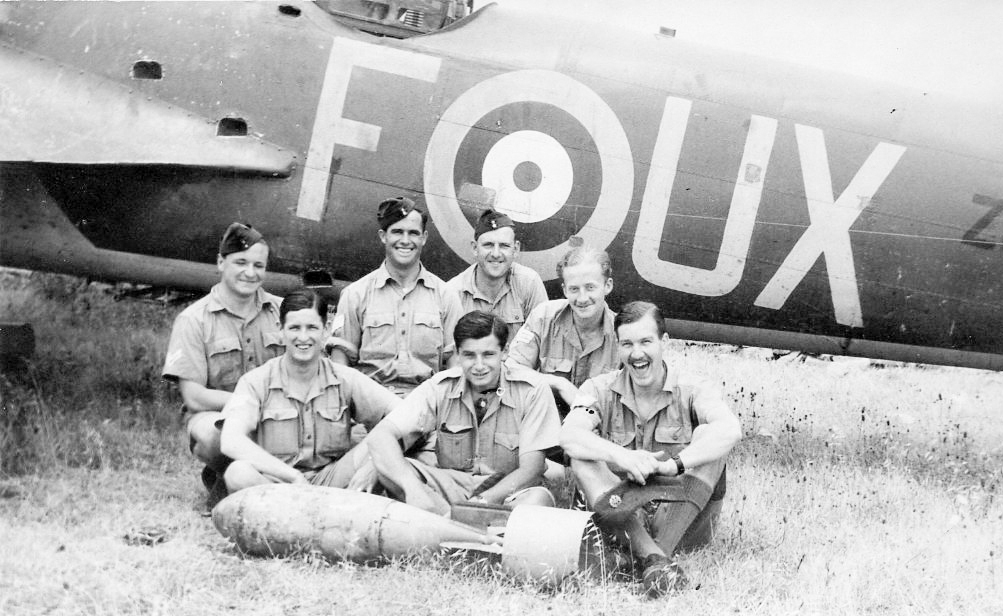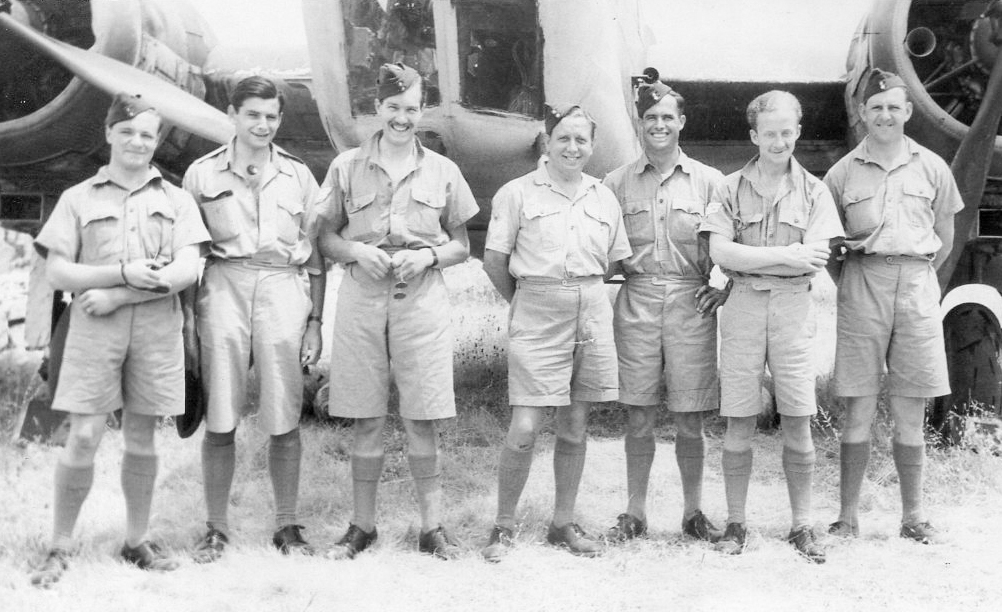By Hugh Hadland
My father married my mother on 6th September 1939 in Oxford while he was learning to fly at Kidlington. As they came out of the church the first air raid siren of their war was sounding – a false alarm – but no one bothered about it. Ironically, she was half Danish, her father being a farmer who came to the UK from Jutland before the war. Olaf Frederik Hansen.
I am named after W/Cdr Hugh Malcolm VC who was killed early in the war. He was a huge friend of my fathers and I feel honoured to have kept his name alive in some small way.

I found the following in my Fathers papers. It is written in pencil and is one of the only things we know about his war.
“The little affair of which I am going to tell took place in the early days of the war. I think I am reminded of this particular incident because it began and ended in an Operations Room, not quite the type of room we know as an Operations “Room” – but let me describe the setting to you.
The airfield was a grass field situated beside a wood in Norfolk; it was a delightful spot and from the air looked rather like a patchwork quilt with a hole in it; the hole being the airfield, the patches plantations of trees of different ages (coniferous?) and as if to complete the rural setting sheep were invariably to be seen grazing the field, their shepherd had to clear them before the aircraft could take off.
It was in the edge of this wood beside the field that our (Blenheim) *censored aircraft were parked and there was a pair of keepers cottages which had been converted into the various offices required by a Squadron. The dividing wall in the lower two rooms of the cottages had been partly demolished and now appeared as one larger room with two fireplaces back to back in the centre, an archway connecting the two rooms on either side. Even in its enlarged state it was still much too small for the purpose and was always a crowded place, with maps and photographs covering the walls, tables and cupboards crammed together, trays and models here and there; it resembled more an untidy country general store than an operational room. In one corner of this room the Operations Officer had his desk, and at this desk sat the Squadron Commander talking to Group HQ on the telephone. I sat at a table in the other half of the room, out of sight and unknown to the Commanding Officer.
The Wing Commander had just taken over the Squadron, we had had some bad luck recently and our CO had been lost, in fact my crew was one of the two experienced crews left, the other having newly arrived. The Squadron had recently been engaged in daylight bombing with some low level shipping attacks thrown in, but the CO had yet to do his first daylight operation, his previous work having been at night.
I suppose I should have made my presence known and departed, but I had sat there so often before, looking through intelligence reports Etc, taking no notice of what went on in the other half of the room, but this time I found myself listening “………alright then, I’ll send the new chaps on a routine patrol and take the two experienced crews with me, we’ll have a look for a ship up the Dutch coast in that area, if we don’t see one we’ll pop inland to that reported dump, failing all we’ll have a look in at Den Helder, should find a ship there….OK……goodbye”. Just like that.
Now the Dutch coast in those days was not a healthy spot, the standard method of search for shipping in that area was to fly as low as possible above the sea until the coast was in sight, turn and fly along it, but if nothing was seen in four minutes, make for home, as the Germans had many fighters stationed in Holland, all very much faster than our Blenheims*, (not this time censored) and it was reckoned that once plotted , a longer stay would give the enemy time to direct his fighters on to us, this of course was discounting the risk of running into a standing patrol.
The quiet room immediately sprang to life, my presence passed unnoticed and in turn I had no time to reflect on what I thought was rather a tall order. The quiet wood became a bustle of manhandled aircraft , armour-piercing bombs and cursing ground- staff , and it then seemed as swiftly still, all the aircrew at briefing, the ground crews waiting at their aircraft. Then again the bustle and noise, the briefing over; this was not yet the lengthy, ordered direction of later years, crews climbed into aircraft, started up, tested, taxied out behind the Squadron Commander and went off in a scrambling formation.
The seeming disorder dissolved as each pilot found his position, I manoeuvred my Blenheim into No 2 position on the CO and saw No 3 take his place, a low sweep across the airfield and course was set for the coast; here the Squadron split up, the two with the Squadron Commander heading for the Dutch coast the remainder breaking away about their own task.
Now there seemed a more determined air about the small formation. I shall ever remember the tightening up, the thrill as the coast was left behind and we flew low above the grey green sea; low to avoid being plotted by the enemy radar. This tense, earnest feeling is, I think, always felt at this moment no matter how many of these trips one does. Visibility was fairly good as the three aircraft flew on towards the enemy held coast my navigator kept me informed of the time to run before our expected sighting and with a few minutes to go the visibility deteriorated as we ran into haze and was now about three miles.
I thought the chances of seeing a ship as we ran straight into the coast very remote, and now with the visibility still worsening as the Dutch* (crossed out, then included) coast came into sight. I visualised our abortive search for the suspected ammunition dump and a run into Den Helder harbour and then……..a ship.
There she was over to port of the formation; not a big ship but certainly more than a trawler, we continued on our way into the coast which was now well in sight and for a moment I thought we were not going to attack. When suddenly the CO turned in toward the ship with the coast now behind, I saw he was attacking from astern and pulled away to follow in after his eleven second delay bombs had gone off, however I saw his bombs hit the water and at the same time his aircraft was hit, turned over on its side and crashed into the sea.
I turned to run in but found that No 3 had beaten me to it, I cursed quietly and watched his run, saw his bombs also hit the water astern, and he was over the ship and away. By this time I had completed another half circuit of the ship and decided to attack from ahead, flying towards the coast, this I did, no apparent return fire to my front gun tracer, bombs away and so was I. And as I turned for home leaving the ship on my port side there was an explosion amidships from my delayed action bombs.
I looked round for No3, expecting him to join me quickly, there was safety in numbers around here and we had been here too long, but all I could see was a speck on the horizon. After making sure that it must be him I set off in pursuit expecting any movement to be enemy fighters. However no opposition appeared to mar the uneventful return flight and I soon gave up trying to catch number three.
I crossed the Norfolk coast in a steady climb and was soon taxying across the grass to the wood beside the field, I gave a full account of the trip to my ground crew and then proceeded to the “cottage” to report to the Operational Officer.
I entered the room and at almost the same spot where I first heard of this operation not many hours before, again unseen and unheard by the occupants of the other half of the room, I heard the other pilot saying that he was ‘chased all the way back to the English coast by a JU 88 (Story heavily underlined at this point!!)”
The JU88, a German light bomber, is very similar looks and performance to the Blenheim.
From what I can ascertain from Pa’s logbook I reckon this took place on 2nd August 1941 in Blenheim V6445 flying from Bodney, a satellite of RAF Watton, in Norfolk with 82 Sqn. The ship was about 2000 tons. His crew that day were SGTs Stanford and Chandler and the flight was 2hrs 20 minutes.
When Pa was posted from 82 Sqn to 17 OTU (Operational Training Unit) on 15th Sept 1941 he had flown a total of 851 hours and was assessed “above the average” as a medium bomber pilot, and “above the average” at low level bombing.
Editor: The aircraft John Hadland witnessed crashing was Blenheim V6026 UX-M crewed by W/C Kenyon O. Burt, Sgt William T. Ellis and F/Sgt Angus D.W. Curr. Four other Blenheims were on the raid V6445 coded UX-E crewed by Sgt John Vincent Hadland, Sgt Stanford and Sgt Chadler , Blenheim T2165 UX-W crewed by Sgt Long, Sgt Nicholson and Sgt Tucker, V6435 coded UX-V crewed by Sgt Hanafy, Sgt Arding and Sgt Bambrough and L4880 coded UX-Z crewed by Sgt Dick, P/o Judd and P/o Race.
There are more details and photos showing the recovery of W/C Burt and his crew together with pictures of their graves on the excellent site maintained by Søren Flensted from Denmark, Airwar over Denmark. See www.flensted.eu.com/194114.shtml and www.flensted.eu.com


Truly fascinating stuff, thanks for publishing. I would have been Kenyon Burt’s nephew – his wife was my aunt/father’s sister who died on 25.12.89. Still have his log books and everything!
On 24th Feb 1940 your father (then Sgt) John Vincent Hadland #742159 was piloting Hawker Demon K5904 at No. 1 AAS Donna Hook. He and his passenger Acting P/O George Emerson Race #77367 were witnesses to the collision between Demon K8196 and Demon K5736
I am going through my Aunt’s stuff, and I found a photo of the RAF School of Administration, Bircham Newton, Equipment Division. The course is No 197 Equipment Officers’ Course, from 29th OCt 1951 to 30th Jan 1952. One of the course members, of whom there were 14 in the Group, was my Aunt, Off. Cadet S.M.Robinson. Another was SQN LDR J V Hadland D F C who was the Course President.
The photo was taken by E E Swain of Hunstanton.